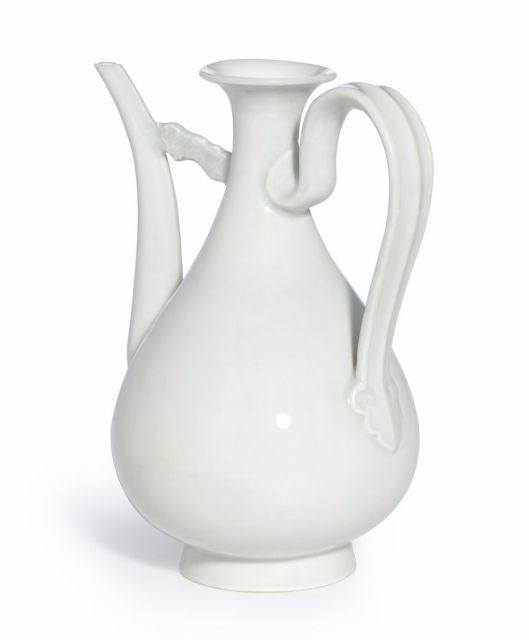A rare white-glazed ewer, Ming Dynasty, Yongle Period (1402-1424)


Lot 3692. A rare white-glazed ewer, Ming Dynasty, Yongle Period (1402-1424); 29.7 cm., 11 5/8 in. Estimate 2,800,000 — 3,500,000 HKD. Lot sold 5,080,000 HKD (518,082 EUR). Photo Sotheby’s
the finely potted pear-shaped body rising from a splayed foot to a generously rounded lower body extending to a narrow waisted neck, the shoulders set with a ribbed ear handle ending in a carved ruyi-head across from the tall spout secured with a strut carved with whispy clouds, all below the trumpet mouth, glazed overall in a thick smooth ‘sweet-white’ (tianbai) glaze.
Note: The milky semi-translucent white glaze, combined with the elegant and balanced shape of this ewer reveals the exceptional craftsmanship and quality of materials achieved at Jingdezhen in the early 15th century. The white glaze was gradually refined through an improved composition and slight raise in firing temperature. The cold blue-tinted glazes of the Song dynasty (960-1279), known as qingbai, developed first to the more subtle, matt and opaque shufutype of the Yuan dynasty (1279-1368), before eventually reaching the superb smooth and pure-white of the Yongle reign, known as tianbai(‘sweet white’). White wares were reserved for ritual ware in the Yongle period, and the tianbaiglaze was specially devised and exclusively reserved for monochrome vessels, a different glaze recipe being used for blue and white. Although ritual vessels feature predominantly among tianbai porcelain, a variety of different ewer shapes, of which the present is perhaps the most characteristic, was recovered at the waste heaps of Jingdezhen and included in the Chang Foundation exhibition Imperial Hongwu and Yongle Porcelain excavated at Jingdezhen, Taipei, 1996, cat. nos 95-99.
Compare a ewer of this form, incised with a floral design and with a loop on the handle, in the Shanghai Museum, Shanghai, illustrated in Lu Minghua, Mingdai guanyao ciqi [Ming imperial porcelain], Shanghai, 2007, pl. 1-11; one in the Manno Art Museum, Osaka, published in Sekai toji zenshu, vol. 14, Tokyo, 1976, pl. 7, sold at Christie’s Hong Kong, 28th October 2002, lot 555; another from the Mr. and Mrs. John D. Rockefeller 3rd collection at the Asia Society, New York, illustrated in Denise Patry Leidy, Treasures of Asian Art, New York, 1994, pl. 171; a fourth ewer in the Indianapolis Museum of Art, Indianapolis, included in the Museum’s exhibition Beauty and Tranquillity. The Eli Lilly Collection of Chinese Art, Indianapolis, 1983, pl. 93.
The form of this pear-shaped ewer, which is often said to have derived from a Middle Eastern metal shape, may in fact have developed from small stumpy egg-shaped ewers produced in the Southern Song dynasty, which had shorter spouts and no separate neck and therefore lacked the joining strut. In the Yuan dynasty a form similar to the present appeared, as seen on aqingbai ewer recovered from a shipwreck sunk off the coast of Sinan in AD 1323, illustrated in Relics Salvaged from the Seabed off Sinan. Materials I, Seoul, 1985, pl. 94; and another from the Meiyintang collection, published in Regina Krahl,Chinese Ceramics from the Meiyintang Collection, vol. 4, London, 2010, pl. 1614. This shape was then refined in proportions and reached its most mature, balanced form in the Yongle reign, after which it disappeared from the Jingdezhen’s repertoire (see Regina Krahl, ‘A Rare Yongle Blue and White Ewer’, Sotheby’s, 8th April 2010, p. 164).

/https%3A%2F%2Fprofilepics.canalblog.com%2Fprofilepics%2F1%2F0%2F100183.jpg)
/https%3A%2F%2Fstorage.canalblog.com%2F03%2F02%2F119589%2F96711876_o.jpg)
/https%3A%2F%2Fstorage.canalblog.com%2F11%2F31%2F119589%2F94773502_o.jpg)
/https%3A%2F%2Fstorage.canalblog.com%2F20%2F83%2F119589%2F94772815_o.jpg)
/https%3A%2F%2Fstorage.canalblog.com%2F26%2F72%2F119589%2F75604929_o.jpg)
/https%3A%2F%2Fstorage.canalblog.com%2F59%2F60%2F119589%2F26458628_o.jpg)


/http%3A%2F%2Fstorage.canalblog.com%2F97%2F49%2F119589%2F129856334_o.jpg)
/http%3A%2F%2Fstorage.canalblog.com%2F25%2F08%2F119589%2F129521423_o.jpg)
/http%3A%2F%2Fstorage.canalblog.com%2F43%2F43%2F119589%2F129237428_o.jpg)
/http%3A%2F%2Fstorage.canalblog.com%2F73%2F38%2F119589%2F128525398_o.jpg)